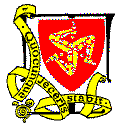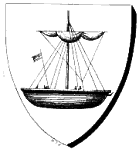 The
Three Legs of Man
The
Three Legs of Man The
Three Legs of Man
The
Three Legs of ManGules, three legs armed, conjoined in fesse at the upper part of the thighs, flexed in triangle, garnished and spurred
That Mann has legs for its arms is well known - what is much less well known is the origin of this device. For many years the sharing of the common device of three legs between Man and Sicily made many assume that there had to be some connection (a theory first put forward by Camden in 1607) - see for example the ingenious theory first put forward by John Newton in 1885 that it was in 1255/6 when the young Prince Edmund of England was promised the throne of Sicily and King Alexander III of Scotland who was visiting London adapted the device for his newly acquired Isle of Man.
A Wagner (Richmond Herald) demonstrates that the device of three legs was associated with Man from at least c.1270 being described as such in several heraldic compilations of that period though only one, Segar's Roll of c.1280 provides an illustration of three legs in chain mail, running clockwise, joined at a triangle (Rey de Man - Gules three mailed legs argent conjoined at the thigh). Note that spurs were a later invention and may well have been derived from the three stars sometimes seen near the feet. Devices based on the trisqueta (triple knot) are well known from the 10th century silver pennies issued at York by the Norse-Irish kings Sithric, Ragnald and Anlaf Cuaran. The rulers of Mann were also associated with this family.
Camden states:
Soon after this the Scots recovered it again under the conduct of Robert Brus; and from that time Thomas Randolph, a warlike Scot, as also a long time after, Alexander, Duke of Albany, stiled themselves Lords of Man, and bore the same arms that the later kings of the island did-viz. three armed legs of a man linked together and bending in the hams, just like the three legs, naked, which were formerly stamped on the coins of Sicily, to signify the three promontories. But yet the ancient arms of the kings of Man was a ship with the sail hoised, with this inscription, Rex Manniae et Insularum,- " The King of Man and of the Islands," as I have seen in the seals they used.
The ship seals will be discussed shortly, the earliest surviving representation of the three legs would appear to be a detail of the arms of the Kings of Man on the Priest's tomb (probably that of Edward IV's chaplain de Grimsby) in Beverley Minster Yorkshire. The earliest representation on the Island is on the 14th century Pillar Cross of Kirk Maughold which probably dates from time of Montagu possession (1333-1391). Another early representation is on the pommell of the sword of state but as this would appear to have spurs it is likely that the sword dates from Stanley period (spurs were only introduced in 15th century).
Although the early representations showed the legs running clockwise (supporting the supposition they are derived from a sun symbol) later representations showed both clockwise and anticlockwise. This latter case gave rise to pun:
With one leg I spurn Ireland,
With the second I kick Scotland,
And with the third I kneel to England(see Mona Miscellany p21)
The modern rendition is to run the legs clockwise.
The Manx Flag is to use the three legs device on a red background - as an official national flag its use dates only from 1931 before which date the Union Flag (commonly referred to as Union Jack) would be flown. However the three legs on a flag is of older origin - the Stanleys used red legs on a white background for their troops and white legs on a red background for naval purposes..
The punning motto 'Quocunque Jesseris Stabit' -generally given as 'which everway I am thrown I will stand'. However the verb 'jeceris' is the second person ('thee') of the future perfect tense of iacere, to throw, hurl, and thus the phrase is probably nearer 'whateverway you will have thrown [it] it will stand'. The motto first made its appearance on John Murrey's brass penny of 1668 where it could be read as 'however it is tested it will pass' which is not a bad motto for a coin for those times when false coins abounded. Possibly these coins gave its familiar association with the three legs. The use of the three legs on the coin (originally issued as a token as post civil war coinage was in very short supply and similar in size to many English tokens of this period - but later legalised by Tynwald) came as one of the cellars (warehouse/shops) used by the Murreys was known as 'the Three Legged chamber' bought by John Murrey(chapman) in 1639 from Robert Banks (Old Deed Onchan Bundle1 #28).

Camden makes reference to these ship seals which do not now exist, presumed lost in the 1731 fire in the Cottonian Library - Megaw tells of the fortuitous timing of J. R. Oliver's enquiry to the British Musem when compiling his collection of historical documents, in that a privately owned document of 1641 Sir Christopher Hatton's Book of Seals (now in Northamtonshire Record. Office) was being bound and the Museum provided him with photographs of the facsimiles in this document (those of 1245 & 1246 though Megaw believes the fragments are from the same seal). Reference to other ship seals of the 1190's are made by Clarencieux King of Arms in 1735/6 in support of the Duke of Athol's claim to the three legs device. Blundell in his manuscript history discusses this ship seal - stating that it was unknown to himself but he would trust Camden.
A. R. Wagner The Origin of the Arms of Man J. Manx Museum VI #76 pp77/8 1959/60
B.R.S. Megaw The Ship Seals of the Kings of Man J. Manx Museum VI #76 pp78/80 1959/60
|
|
||
|
Any comments, errors or omissions
gratefully received The
Editor |
||